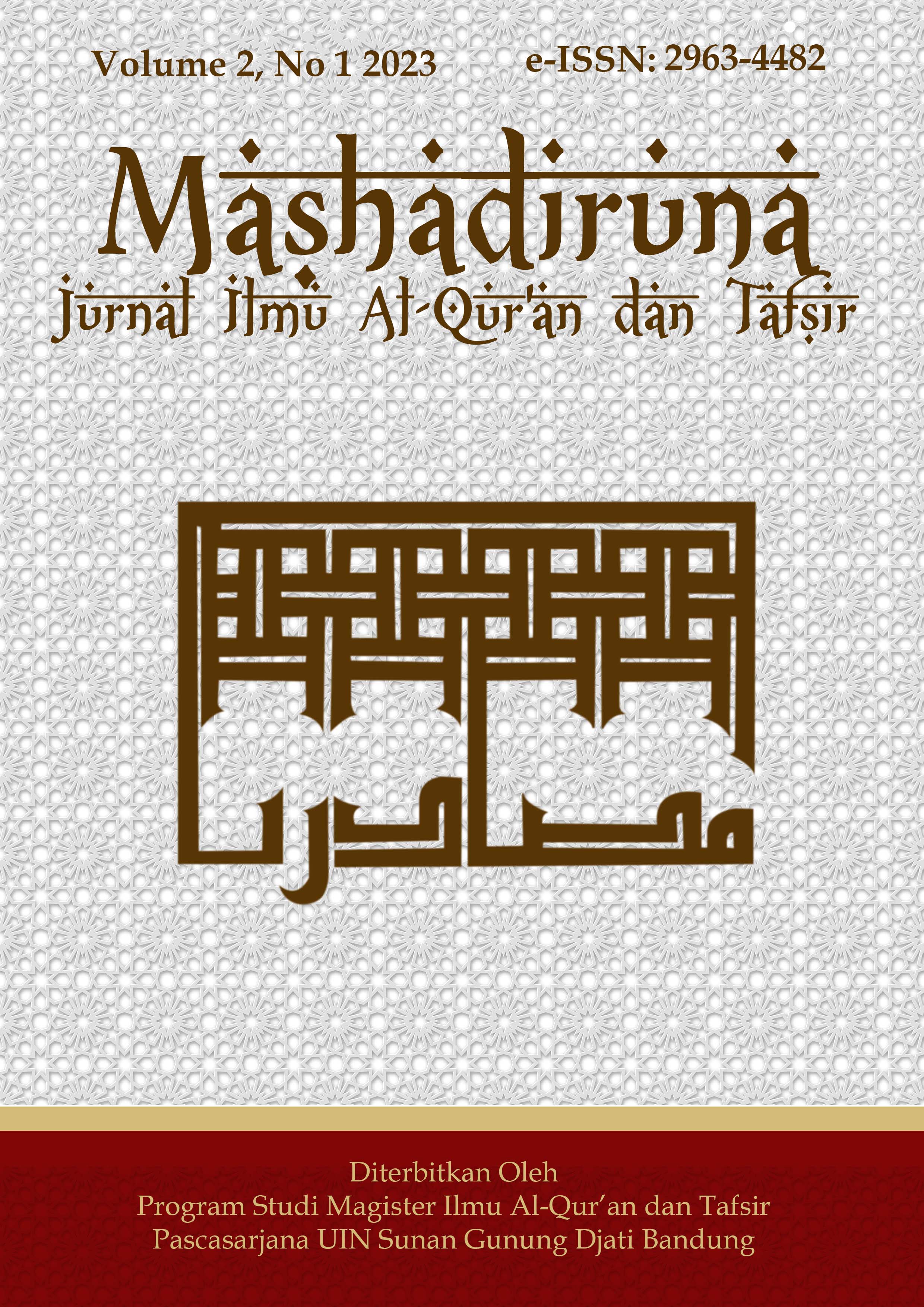I'Jaz Concept and its Relationship with Miracles in the Qur'an
DOI:
https://doi.org/10.15575/mjiat.v2i2.25240Keywords:
I'jaz, Miracles, Al-Qur'anAbstract
I'jaz is the ability to subdue and show himself above others. When this term was applied to the Qur'an, the holy book brought by the Prophet was able to subdue all the writings that ever existed, while also crowning the Qur'an as a miracle as well as the most noble and undeniable book. The miracles of the Qur'an cannot be matched. This is manifested in aspects of the beauty of language, the stories contained in it, in addition to monotheism, the rules of the Shari'a, and so on, as well as scientific information that is extraordinarily complete when examined in depth. To appreciate the miracles of the Qur'an, every Muslim should fulfill the rights of the Qur'an by reading, memorizing, studying, analyzing and applying it in daily life as a guide for those who are pious.References
Abdurrahman, A. (2015). Maqal fi al-Insan, diterjemahkan oleh M Adib al Arif dengan judul “Manusia: Sensitivitas Hermeneutika Al-quranâ€, Cet. I.
al-Baqillanı, A. B. (1993). I jaz al-Quran. In Beirut: Dar wa Maktabah al-Hilal.
Al-Ghazali, S. M. (1996). Berdialog Dengan Al-Qurán. Mizan.
Al-Qardhawi, Y. (1999). Berinteraksi dengan al-Quran. Gema Insani Press.
Al-Qattan, M. (1973). Mabahith fi ‘Ulum al-Qur’an. Dinamika Barakah Utama.
Al-Qattan, M. K. (2001). Studi Ilmu-ilmu al-Qur’an. terj. Mudzakir AS.
al-Sabuni, M. (1986). Rawa’i’al-bayan: Tafsir ayat al-ahkam min al-Qur’an. Alim al-kutub.
Al-ZarqÄnÄ«, M. al-‘Aẓīm. (1995). ManÄhil al-‘IrfÄn fÄ« ‘UlÅ«m al-Qur’Än. Cet. I.
Al-Zindani, A. M. bin A., & Majid, A. (1997). Mukjizat Al-Qur’an dan As-Sunnah tentang IPTEK. Jakarta: Gema Insani Press.
Al–Qurtubi, M. bin A. abi B. ‘Abdullah. (2006). Tafsir al–Qurtubi al–Jami li ahkam al–Qur’an. Daae Ar – Risalah.
An-NajjÄr, Z. R. M. (2003). á¹¢uwar Min Tasbīḥ Al-KÄinÄt LillÄh. In Mesir: DÄr Nahdhoh Misr.
As-Shalih, S. (2008). Membahas ilmu-ilmu Al-Qur’an. Pustaka Firdaus.
As-SuyÅ«thi, J. (1986). Al-ItqÄn FÄ« UlÅ«mil QurÄn. Darul Kutub Ilmiyah, Bairut, Libanon.
Baiquni, A. (1983). Islam dan ilmu pengetahuan modern. Pustaka.
Hasan Basri Talhas. (2001). Spektrum Saintifikasi al-Qur’an. Bale Kajian Tafsir al-Quran Pase.
Ibrahim, M. I. (n.d.). Mu’jam Alfadz wa al-A’lam al-Qur’an. In Kairo: Dar al-Fikr al-Arabi, t. th.
Khaldun, I. (2015). The Muqaddimah: An Introduction to History-Abridged Edition. Princeton University Press.
Khallaf, A. W. (1994). Ilmu Usuf Fikih. Toha Putra.
Manna, A.-Q. S. (2006). Pengantar Studi Ilmu Al-Quran. Tarj. Aunur Rafiq El-Mazni, Jakarta, Pustaka Al-Kautsar.
Misrawi, Z. (2007). Al-Quran kitab toleransi: inklusivisme, pluralisme dan multikulturalisme. Penerbit Fitrah.
Naufal, A. R. (1987). Al-Quran dan sains modern. Husaini, Bandung.
Pickthall, M. (1953). The meaning of the glorious Koran (Vol. 94). New American Library New York.
Rasyad, R. (2021). Konflik dalam Al-Quran. Jurnal Ilmiah Al-Mu’ashirah: Media Kajian Al-Qur’an Dan Al-Hadits Multi Perspektif, 18(1), 12–29.
Rosihon, A. (2018). Pengantar Ulumul Qur’an (Edisi revi). Pustaka Setia.
Sari, D. P. (2017). Pendidikan Karakter Berbasis Al-Quran. Islamic Counseling, 1(1), 1–24.
Setiawan, M. N. K., & Dzulmanni. (2005). Al-Qur’an kitab sastra terbesar. EL-SAQ Press.
Shihab, M. Q. (1996). Wawasan Al-Quran: Tafsir Tematik atas Pelbagai Persoalan Umat. Mizan Pustaka.
Shihab, M. Q. (2003a). Tafsir al-Mishbah, Vol 3. Lentera Hati.
Shihab, M. Q. (2003b). Tafsir al-Mishbah (V. 1 (ed.)). Lentera Hati.
Shihab, Q. (1999). Sejarah dan Ulum Al Qur’an. Pustaka Firdaus.
Silverman, D. (2015). Interpreting qualitative data. Sage.
Syahin, A. S. (2006). Saat al-Qur’an butuh pembelaan. Jakarta: Erlangga.
Zaini, M. (2012). Sumber-Sumber Penafsiran Al-Quran. Substantia: Jurnal Ilmu-Ilmu Ushuluddin, 14(1), 29–36.
Zulaiha, E., Ahadah, A., & Malaka, A. (2021). Historical Development of Thematic Interpretation of al-Qur’an. Jurnal Iman Dan Spiritualitas, 1(3), 311–316.
Downloads
Published
Issue
Section
License
Authors who publish with this journal agree to the following terms:
- Authors retain copyright and grant the journal right of first publication with the work simultaneously licensed under a Creative Commons Attribution License that allows others to share the work with an acknowledgment of the work's authorship and initial publication in this journal.
- Authors are able to enter into separate, additional contractual arrangements for the non-exclusive distribution of the journal's published version of the work (e.g., post it to an institutional repository or publish it in a book), with an acknowledgment of its initial publication in this journal.
- Authors are permitted and encouraged to post their work online (e.g., in institutional repositories or on their website) prior to and during the submission process, as it can lead to productive exchanges, as well as earlier and greater citation of published work (See The Effect of Open Access).
